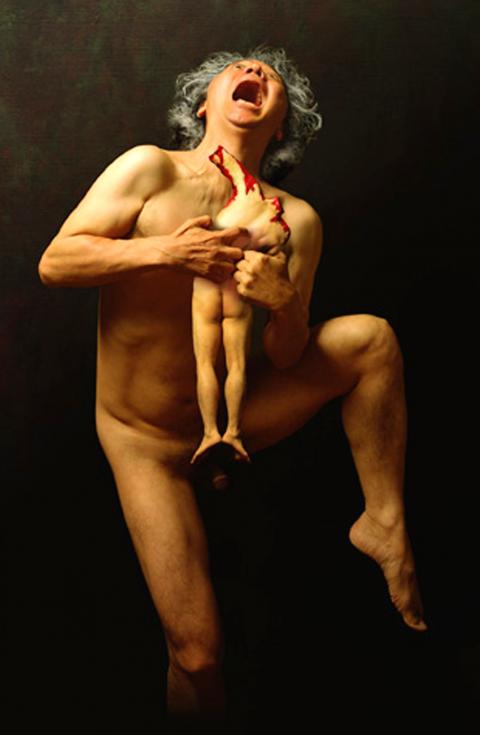The tastiest parts of the human body are the breasts and the buttocks.
So says St Jerome, the church father, in his treatise Against Jovianus, in which he describes the dietary preferences of the Attacots, a tribe living in Roman Britain.
They were, of course, not alone in eating their fellow humans. All Cannibals, an exhibition at the Maison Rouge in Paris, starts with a 1593 print depicting Brazilian women and children sitting around the severed head of a man, happily munching the rest of his body.

Photo: Bloomberg
Whether this edifying scene is a case of exo- or endocannibalism, the consumption of an enemy or a deceased relative, isn’t clear.
The title of the show, which displays works by about 30 mostly contemporary artists, is a quote from anthropologist Claude Levi-Strauss: “We are all cannibals. After all, the simplest way to identify with someone is to eat him.”
Gruesome Goya
From Brazil the show jumps forward to Francisco de Goya and the morbid symbolists Odilon Redon, Felicien Rops and James Ensor. Goya appears in different guises: Next to his Caprichos, there are prints from his Disasters of War, altered by the Chapman brothers.
Saturn Devouring His Son, one of Goya’s most gruesome canvases, has morphed into two photographs: One shows an assemblage by Vik Muniz, who recreated the painting out of junk. The other is a self-portrait by the Japanese “appropriation artist” Yasumasa Morimura, who specializes in substituting faces and bodies in famous pictures with his own.
Cannibalism, we are told, is a popular theme in contemporary Japanese art. Issei Sagawa, a mentally disturbed student who killed and ate a Dutch girl in 1981, became a celebrity after he had been found legally insane and even became a food critic.
Jeanette Zwingenberger, the curator, says in the press material that she turned down works that smacked too much of gore. In fact, even the fainthearted aren’t in danger of being overcome by twinges of nausea.
Michel Journiac’s Mass for a Body, a sacrilegious performance during which he distributed sausages made with his blood, is only visible on a video. Adriana Varejao’s painting of guts spilling out of a tiled wall looks almost abstract.
DARK HUMOR
Gilles Barbier’s photomontage displaying six clones of himself butchering each other or Renato Garza Cervera’s Genuine Contemporary Beast, the skin of a tattooed man splayed on the floor like a bearskin rug, are nice examples of black humor. (Cervera has said that he was inspired by gang wars in Los Angeles.)
Much is made of the female breast and the feeding of babies. That seems far-fetched.
On the other hand, the rich world of vampires is only mentioned in passing.
If you expect a systematic and thorough examination of a fascinating subject, you’ll be disappointed. But as an introduction, the show is worth a visit.
All Cannibals is at Maison Rouge, Paris, through May 15. On the Net: www.lamaisonrouge.org

This month the government ordered a one-year block of Xiaohongshu (小紅書) or Rednote, a Chinese social media platform with more than 3 million users in Taiwan. The government pointed to widespread fraud activity on the platform, along with cybersecurity failures. Officials said that they had reached out to the company and asked it to change. However, they received no response. The pro-China parties, the Chinese Nationalist Party (KMT) and Taiwan People’s Party (TPP), immediately swung into action, denouncing the ban as an attack on free speech. This “free speech” claim was then echoed by the People’s Republic of China (PRC),

Exceptions to the rule are sometimes revealing. For a brief few years, there was an emerging ideological split between the Democratic Progressive Party (DPP) and Chinese Nationalist Party (KMT) that appeared to be pushing the DPP in a direction that would be considered more liberal, and the KMT more conservative. In the previous column, “The KMT-DPP’s bureaucrat-led developmental state” (Dec. 11, page 12), we examined how Taiwan’s democratic system developed, and how both the two main parties largely accepted a similar consensus on how Taiwan should be run domestically and did not split along the left-right lines more familiar in

Many people in Taiwan first learned about universal basic income (UBI) — the idea that the government should provide regular, no-strings-attached payments to each citizen — in 2019. While seeking the Democratic nomination for the 2020 US presidential election, Andrew Yang, a politician of Taiwanese descent, said that, if elected, he’d institute a UBI of US$1,000 per month to “get the economic boot off of people’s throats, allowing them to lift their heads up, breathe, and get excited for the future.” His campaign petered out, but the concept of UBI hasn’t gone away. Throughout the industrialized world, there are fears that

Most heroes are remembered for the battles they fought. Taiwan’s Black Bat Squadron is remembered for flying into Chinese airspace 838 times between 1953 and 1967, and for the 148 men whose sacrifice bought the intelligence that kept Taiwan secure. Two-thirds of the squadron died carrying out missions most people wouldn’t learn about for another 40 years. The squadron lost 15 aircraft and 148 crew members over those 14 years, making it the deadliest unit in Taiwan’s military history by casualty rate. They flew at night, often at low altitudes, straight into some of the most heavily defended airspace in Asia.